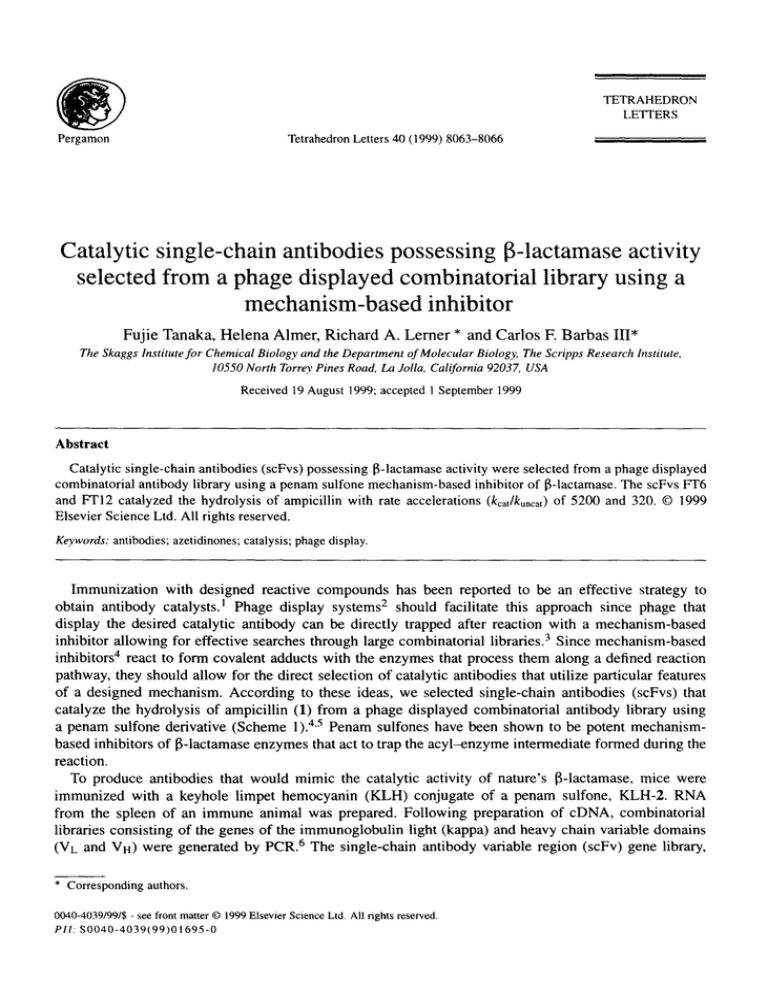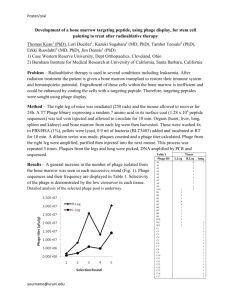
TETRAHEDRON
LETI'ERS
Pergamon
Tetrahedron Letters 40 (1999) 8063-8066
Catalytic single-chain antibodies possessing 13-1actamase activity
selected from a phage displayed combinatorial library using a
mechanism-based inhibitor
Fujie Tanaka, H e l e n a Almer, Richard A. Lerner * and Carlos F. Barbas III*
The Skaggs Institute for Chemical Biology and the Department of Molecular Biology, The Scripps Research Institute,
10550 North Torrey Pines Road, La Jolla, California 92037, USA
Received 19 August 1999; accepted 1 September 1999
Abstract
Catalytic single-chain antibodies (scFvs) possessing 13-1actamase activity were selected from a phage displayed
combinatorial antibody library using a penam sulfone mechanism-based inhibitor of 13-1actamase. The scFvs FT6
and FTI2 catalyzed the hydrolysis of ampicillin with rate accelerations (kcat/kuncat) of 5200 and 320. © 1999
Elsevier Science Ltd. All rights reserved.
Ke>.,words: antibodies; azetidinones; catalysis; phage display.
Immunization with designed reactive compounds has been reported to be an effective strategy to
obtain antibody catalysts, l Phage display systems 2 should facilitate this approach since phage that
display the desired catalytic antibody can be directly trapped after reaction with a mechanism-based
inhibitor allowing for effective searches through large combinatorial libraries. 3 Since mechanism-based
inhibitors 4 react to form covalent adducts with the enzymes that process them along a defined reaction
pathway, they should allow for the direct selection of catalytic antibodies that utilize particular features
of a designed mechanism. According to these ideas, we selected single-chain antibodies (scFvs) that
catalyze the hydrolysis of ampicillin (1) from a phage displayed combinatorial antibody library using
a penam sulfone derivative (Scheme l). 4,5 Penam sulfones have been shown to be potent mechanismbased inhibitors of ~-lactamase enzymes that act to trap the acyl--enzyme intermediate formed during the
reaction.
To produce antibodies that would mimic the catalytic activity of nature's 13-1actamase, mice were
immunized with a keyhole limpet hemocyanin (KLH) conjugate of a penam sulfone, KLH-2. RNA
from the spleen of an immune animal was prepared. Following preparation of cDNA, combinatorial
libraries consisting of the genes of the immunoglobulin light (kappa) and heavy chain variable domains
(VL and VH) were generated by PCR. 6 The single-chain antibody variable region (scFv) gene library,
* Corresponding authors.
0040-4039/99/$ - see front matter© 1999ElsevierScienceLtd. All rights reserved.
P11:S0040-4039(99)01695-0
8064
= H
Ph
H
H2N~ O ~ " . ~
Ampicillin(1)
0
Ph
H H
scFv. H2N~ . N ~ ~
.Ph H
0
Catalytic
COOH
o o 2-
OOH
COOH
KLH-2: R = KLH-NHCO(CH2)7
BSA-2: R = BSA-NHCO(CH2)7
3: R = CH3
Scheme 1.
in which VL and VH genes are connected with DNA coding for an 18-amino acid polypeptide linker
(SSGGGGSGGGGGGSSRSS) region, was prepared by overlap fusion PCR. To avoid degradation of the
penam sulfone by [3-1actamase enzyme that is typically used as a vector selection marker, we constructed
a novel vector, pNPC3zeo, with a zeocin resistance gene. The scFv gene library was ligated into the SfiI
sites of pNPC3zeo. 7 Transformation into Eschericia coli (E. coli) ER2537 cells produced a library of
6× 106 members. The phage library was prepared using helper phage VCS-M13 and isolated according
to standard protocols. 6 In this approach, the scFv proteins are displayed on the surface of the phage as a
fusion protein with the phage gene III protein.
Phage panning was initiated by incubating 4.8x 10 l° phage particles in a microtiter plate coated with
bovine serum albumin (BSA) conjugate, BSA-2. The unbound phage were removed by washing 10 times
with 0.5% Tween 20/TBS (50 mM Tris-HC1, 150 mM NaC1, pH 7.5) (TBST) and then bound phage
were eluted by trypsin digestion and used to infect ER2537 cells. In the next three rounds of selection,
the wells were washed 10 times with TBST and once with 50 mM citric acid (pH 2.5) to remove all
noncovalently bound phage. To exclude phage that bind to BSA alone, for the third and fourth rounds of
selection, phage were added first to the BSA-coated wells, and then transferred to BSA-2-coated wells.
After the fourth round of panning, plasmid DNA was isolated and the selected scFv encoding genes were
moved to an expression vector, pZErH6HA s that expresses the scFv with an amino terminal histidine tag
(H6) and a carboxy terminal hemagglutinin decapeptide tag (HA). A panel of 12 individual clones was
assayed by ELISA for the production of soluble scFv capable of binding to BSA-2. Citric acid washes
were used to remove proteins that bound noncovalently. The binding of eight antibodies was insensitive
this acid treatment.
To study catalytic activity, the scFv proteins were produced using pZErH6HA and pAraH6HA 9 vectors
in E. coli XL1-Blue cells and were purified by H6 affinity purification followed by FPLC cationexchange chromatography. The hydrolysis of 1 (200 pM) in 10% DMSO/PBS (10 mM Na2HPO4, 1.8
mM KH2PO4, 137 mM NaC1, 2.7 mM KCI, pH 7.4) at 24°C was followed by monitoring the decrease of 1
by HPLC. The most active antibodies, FT6 and FT12, were characterized in detail. For large scale protein
production, pAraH6HA was used for scFv FT6 and pGAPZ~xA vector in yeast Pichia pastoris was used
for scFv FT12. l0 The highly purified scFvs FT6 and FT12 were also positive in the ELISA against BSA-2
using the acid washing condition. Since antibody-antigen interaction are typically disrupted at low pH,
this result suggests that these antibodies bind BSA-2 covalently.
Antibodies FT6 and FT12 displayed saturation kinetics in their hydrolysis of 1. Kinetic data fit the
Michaelis-Menten equation. The kinetic parameters of FT6 and FT12 are shown in Table 1. The rate
accelerations above background hydrolysis (kcat/kuncat) with FT6 and FT12 were 5200- and 320-fold,
respectively. Burst-type kinetic behavior was not detected in these reactions. Both antibody catalyzed
hydrolysis reactions of 1 were inhibited by the addition of sulfone 3. When antibody FTI2 was mixed
with 3 and the hydrolysis of 1 was measured immediately, FT12 catalyzed the hydrolysis with partial
inhibition by 3. However, when FT12 (10 pM) was mixed with 3 (50 laM) and the mixture was left
8065
Table 1
Kinetic parameters of the scFv-catalyzed hydrolysis of Ampicillin (1)~
scFv
FT6
FT12
Krn
kcat
560 laM
162 laM
kcat/kuncatb
2.9 x 10-1 min -1
1.8 x 10-2 min -1
Ki (inhibitor 3)
5200
320
NDc
26 pM d
a Reaction conditions: 10% DMSO/PBS, pH 7.4, 24 °C. b The first order kinetic
constant of the background reaction (kuncat) was 5.6 x 10-5 min-1, c Not
determined. See text. d Ki was determined by Dixon plots.
v L
FT6
FTI2
CDRI
CDR2
ELQMTQSPAIMSAS
PGEKVTMTC
SAS S SVSYMYWYQQKPGS
S PRLLI YD'PSNLAS
--V ....................................................
FT6
FTI2
GVPVRFSGSGSGTSYSLTI
...................
FT6
FTI2
KVKLEESGGGLVQ
............
FT6
FTI2
RFT I SRDNARNI LYLQMS
..................
VH
CDR3
I RMEAEDAATYYCQQWSNYPPTFG
S ..............
Y-G--L---A
SGTKLE I K
..... L-
CDRI
CDR2
PGRSLKLSCAASGFTF
S SYGMSWVRQTPDKRLEWVAS
I SNGGSTYY
PDSVKG
K--G ................
A ........ E ..........
S ............
CDR3
SLRSEDTAMYYCASLTRAYWGQGTLVTVSAA
G .............
IL ...............
Figure 1. The deduced amino acid sequences of VL and VH of FT6 and FTI2. Dashes designate identity. CDR (underlined)
designation is according to the consensus described by Kabat et al.~2
for 1 day, the catalytic activity towards the hydrolysis of 1 (200 laM) was not detected. The complete
modification of the antigen-combining site of the scFv with sulfone 3 occurred slowly and this timedependent inactivation suggests an irreversible covalent modification of the antigen-combining site. 4'll
Antibody FT12 did not catalyze the decomposition of sulfone 3. In the case of scFv FT6, the hydrolytic
decomposition of sulfone 3 was also catalyzed: kcat=l.3× 10 -1 min -l, Km=380 laM, and kcat/kuncat=990
(kuncat= 1.3 × 10 -4 min-l). A time-dependent inactivation was also observed in the FT6-catalyzed reaction.
The deduced sequences of scFvs FT6 and F T I 2 are shown in Fig. 1. The sequences of FT6 and
FT12 are highly homologous. Although hydrolytic antibodies generated against phosphonates and
phosphonamidates often share c o m m o n structural features key to their catalytic mechanism, 13 FT6 and
FT12 did not have a significant homology to those hydrolytic antibodies that have been described in the
literature.
In conclusion, antibodies that catalyze the hydrolysis of 13-1actams were obtained from a phage
displayed combinatorial library using a mechanism-based inhibitor of [3-1actamase. These results suggest
that mechanism-based inhibitors provide an effective means for the direct selection of catalytic antibodies
from phage display libraries.
References
1. (a) Wagner, J.; Lerner, R. A.; Barbas llI, C. E Science 1995, 270, 1797. (b) Wirsching, E; Ashley, J. A.; Lo, C.-H.; Janda,
K. D.; Lerner, R. A. Science 1995, 270, 1775. (c) Barbas 1II, C. F.; Heine, A.; Zhong, G.; Hoffmann, T.; Gramatikova, S.;
Bjornestedt, R.; List, B.; Anderson, J.; Stura, E. A.; Wilson, I. A.; Lerner, R. A. Science 1997, 278, 2085. (d) Zhong, G.;
Lerner, R. A.; Barbas III, C. E Angew. Chem., Int. Ed. Engl. 1999, in press.
2. (a) Rader, C.; Barbas III, C. F. Curr. Opin. Biotechnol. 1997, 8, 503. (b) Burton, D. R.; Barbas III, C. F. Advances in
Immunology 1994, 57, 191.
8066
3. (a) Janda, K. D.; Lo, C.-H. L.; Li, T.; Barbas III, C. E; Wirsching, E; Lerner, R. A. Proc. Natl. Acad. Sci. U.S.A. 1994, 91,
2532. (b) Janda, K. D.; Lo, L.-C.; Lo, C.-H. L.; Sire, M.-M.; Wang, R.; Wong, C.-H.; Lerner, R. A. Science 1997, 275, 945.
(c) Lo, C.-H. L.; Wentworth, P.; Jung, K. W.; Yoon, J.; Ashley, J. A.; Janda, K. D. J. Am. Chem. Soc. 1997, 119, 10251.
4. (a) Silverman, R. B. Mechanism-based Enzyme Inactivation: Chemistry and Enzymology; CRC Press: 1988; Vol. 1. (b)
Fisher, J.; Charnas, R. L.; Bradley, S. M.; Knowles, J. R. Biochemistry 1981, 20, 2726. (c) Brenner, D. G.; Knowles, J. R.
Biochemistry 1981, 20, 3690.
5. Trapping of phage displayed 13-1actamaseenzyme by a penam sulfone derivative has been reported: Soumillion, P.; Jespers,
L.; Bouchet, M.; Marchand-Brynaert, J.; Winter, G.; Fastrez, J. J. Mol. Biol. 1994, 237, 415.
6. Phage Display of Proteins and Peptides: A Laboratory Manual; Barbas III, C. F.; Burton, D.; Silverman, G.; Scott, J.,
Eds.; Cold Spring Harbor Laboratory Press: Cold Spring Harbor, New York, 2000, in press.
7. NPC3zeo was constructed from pComb3H 2 by insertion of the zeocin resistance gene into the middle of the 13-1actamase
coding region. The zeocin resistance gene was taken from pPICZe(A vector (lnvitrogen) by PCR.
8. pZErH6HA vector was constructed from pZErO-1 (Invitrogen).
9. Barbas III, C. F.; Wagner J. Methods: a Companion to Methods in Enzymology 1995, 8, 94.
10. The scFv protein concentration was determined by Bradford analysis.
11. Tanaka, F.; Lerner, R. A.; Barbas III, C. E Chem. Commun. 1999, 1383.
12. Kabat, E. A.; Wu, T. T.; Perry, H. M.; Gottesman, K. S.; Foeller, C. Sequences of Proteins of Immunological Interest, 5th
Ed.; US Public Health Service, National Institute of Health: Bethesda, MD, 1991.
13. MacBeath, G.; Hilvert, D. Chemistry and Biology 1996, 3, 433.







